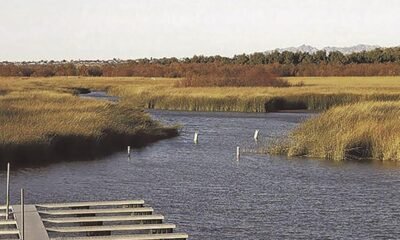border
Just After the Longest Day: No More Deaths Distributes Hundreds of Gallons of Water in Arizona Desert

Two days following the summer solstice, volunteers from No More Deaths deposited 364 one-gallon water bottles in the Altar Valley, approximately 33 miles southwest of Tucson. The bottles were strategically placed along trails often used by migrants trying to bypass the Border Patrol checkpoint on Highway 286.
Days of oppressive heat nearing triple digits preceded the water drop. Fortunately, temperatures dipped slightly on Sunday, reaching 95 degrees by late morning. Since 2004, No More Deaths has sought to save lives by providing water and food in the desert, countering increasingly aggressive border policies. The organization also runs the Byrd Camp, which offers medical assistance and clothing to migrants near Arivaca, Arizona.
In 2022 alone, volunteers distributed 13,096 gallons of water, according to organizer Ary Ospina. “This marks the start of the summer months when many deaths occur in the desert,” she stated, referencing Friday’s summer solstice that saw temperatures soar to 105 degrees.
Since the 1990s, over 8,600 individuals have died attempting to cross the U.S.-Mexico border, with Arizona accounting for 4,384 of those recoveries. Advocates often label Arizona’s deserts as a “graveyard of the missing,” attributing the fatalities to U.S. border enforcement strategies that prioritize deterrence over safety.
Jason de León, a UCLA professor, described the desert in his book as a “Land of Open Graves,” emphasizing the devastating impact of these policies. A strategic plan initiated in 1994, during the Clinton administration, shifted enforcement tactics to funnel migrants through more dangerous desert terrain. The expectation that perilous routes would discourage crossings has instead led to increased fatalities.
In recent years, smuggling operations have evolved. Previously, larger groups relied on guides known as “coyotes.” Today, many small groups navigate via social media, increasing the risk for migrants, who may be abandoned if they lag behind.
Shifts in migration patterns have been notable. Thousands of asylum seekers, barred from official entry points, have recently ventured into remote desert areas, such as east of Sasabe, Arizona. A surge of cold weather in December 2023 also saw No More Deaths volunteers assisting freezing migrants.
Furthermore, a shift to harsher terrain in New Mexico has occurred as Texas officials, via Operation Lone Star, have enforced stricter border measures. As a result, the El Paso sector has become the most dangerous crossing point along the U.S.-Mexico border.
Ospina pointed out that recent efforts, including the Sunday water drop, are part of a civil initiative aimed at protecting human rights. No More Deaths has faced legal challenges for its humanitarian work, including a reversal of convictions for leaving water in a protected wildlife refuge.
This past weekend, teams loaded crates of water onto pickup trucks and traveled down a winding dirt road in Arizona. The volunteers planned to distribute water along less traveled paths to increase access for migrants. Ospina remarked on the significance of spreading out supplies, “so more people can find it.”
Prior to the water drop, volunteers decorated jugs with inspirational messages to indicate their purpose. On the day of the drop, they hiked through the arid landscape, balancing heavy loads of water and food.
As noted by No More Deaths, it is virtually impossible for migrants to carry enough water for a successful crossing. A 2021 UCLA study suggested that individuals, particularly pregnant women, can deplete nearly three gallons of water daily, underscoring the perilous conditions faced.
As apprehensions at the border have declined, investigations revealed that 156 sets of human remains were found in the Arizona desert last year—an alarming figure. Ospina emphasized the importance of acknowledging these deaths, noting the shifting migration patterns and increased risks.
The rising sun brought higher temperatures, but the volunteers remained resolute. Over several miles, they successfully distributed 90 gallons of water, with other teams working in different directions. Each gallon, placed carefully in the shade, offers a lifeline for those who may pass through in the future.

















